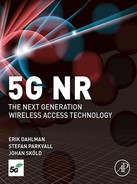Preface
Long-Term Evolution (LTE) has become the most successful wireless mobile broadband technology across the world, serving billions of users. Mobile broadband is, and will continue to be, an important part of future cellular communication, but future wireless networks are to a large extent also about a significantly wider range of use cases and a correspondingly wider range of requirements. Although LTE is a very capable technology, still evolving and expected to be used for many years to come, a new 5G radio access known as New Radio (NR) has been standardized to meet future requirements.
This book describes NR, developed in 3GPP (Third Generation Partnership Project) as of late Spring 2018.
Chapter 1 provides a brief introduction, followed by a description of the standardization process and relevant organizations such as the aforementioned 3GPP and ITU in Chapter 2. The frequency bands available for mobile communication are covered in Chapter 3 together with a discussion on the process for finding new frequency bands.
An overview of LTE and its evolution is found in Chapter 4. Although the focus of the book is NR, a brief overview of LTE as a background to the coming chapters is relevant. One reason is that both LTE and NR are developed by 3GPP and hence have a common background and share several technology components. Many of the design choices in NR are also based on experience from LTE. Furthermore, LTE continues to evolve in parallel with NR and is an important component in 5G radio access.
Chapter 5 provides an overview of NR. It can be read on its own to get a high-level understanding of NR, or as an introduction to the subsequent chapters.
Chapter 6 outlines the overall protocol structure in NR, followed by a description of the overall time–frequency structure of NR in Chapter 7.
Multiantenna processing and beam-forming are integral parts of NR. The channel sounding tools to support these functions are outlined in Chapter 8, followed by the overall transport-channel processing in Chapter 9 and the associated control signaling in Chapter 10. How the functions are used to support different multi-antenna schemes and beamforming functions is the topic of Chapters 11 and 12.
Retransmission functionality and scheduling are the topics of Chapters 13 and 14, followed by power control in Chapter 15 and initial access in Chapter 16.
Coexistence and interworking with LTE is an essential part of NR, especially in the nonstandalone version which relies on LTE for mobility and initial access, and is covered in Chapter 17.
Radio-frequency (RF) requirements, taking into account spectrum flexibility across large frequency ranges and multistandard radio equipment, are the topic of Chapter 18. Chapter 19 discusses the RF implementation aspects for higher frequency bands in the mm-wave range.
Finally, Chapter 20 concludes the book with an outlook to future NR releases.
